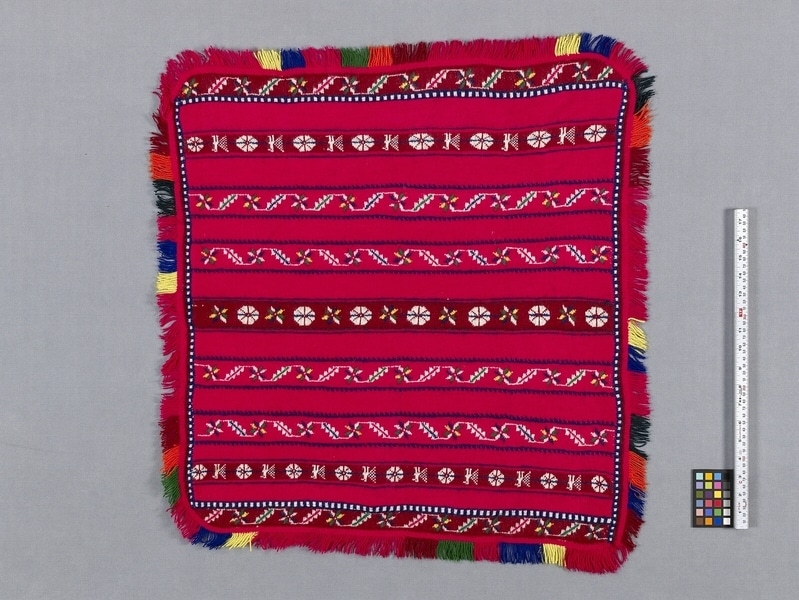Cloth Item Number: Sf947 from the MOA: University of British Columbia


Description
A pink rectangular knitted cloth with a multi-colour woven fringe. The field is divided into nine pattern bands outlined with blue stripes. Six bands repeat florets joined by stepped oblique lines. Two bands alternate six part circles with profile standing birds while the central band alternates florets and circles. Blue bands with white squares outline the field.
History Of Use
Knitting is traditionally done by men and boys for a range of caps worn by female children and males of all ages. Recently, the knitters have been producing vests, coin purses, gloves, ties and sweaters for sale to tourists. This rectangular cloth, worn on the back of a Sikuri dancer, is another innovation in knitting. The Sikuri dance is performed on June 24, El Dia de Campesino, during the community fair, July 25 - Aug. 5 and on some Catholic holidays. The Sikuri dancers wear braided wigs, feathered hats and play the pan-pipes while doing very structured, traditional dances.
Specific Techniques
Plain knitting done circularly on five needles with extra colours carried on the inside for local colour areas. Cut after knitting and edgings sewn on. Fringe band is plain weave.
Cultural Context
Male Sikuri dancer.
Narrative
Made and used in Sikuri dancing by Marcialino Quispe Huatta. One corner of the cloth is folded down and the fold corners are pinned at the shoulder blades to the shirt and vest. Marcialino was very proud of his unusual pano and only decided to sell it after considerable hesitation.
Item History
- Made by Marcialino Quispe Huatta (Maker) in Taquile, Puno, Peru during 1983
- Collected by Mary Frame during 1984
- Owned by Mary Frame before May 8, 1986
- Received from Mary Frame (Seller) and Museum of Anthropology Shop Volunteers (Funding source) on May 8, 1986
What
- Name
- Cloth
- Identification Number
- Sf947
- Type of Item
- cloth
- Material
- wool fibre, synthetic fibre and synthetic dye
- Manufacturing Technique
- knitted, woven, sewn and retwisted
- Overall
- height 72.2 cm, width 69.6 cm
Who
- Culture
- Quechua
- Creator
- Marcialino Quispe Huatta (Maker)
- Field Collector
- Mary Frame
- Previous Owner
- Mary Frame
- Received from
- Mary Frame (Seller) and Museum of Anthropology Shop Volunteers (Funding source)
Where
- Holding Institution
- MOA: University of British Columbia
- Made in
- Taquile, Puno, Peru
When
- Creation Date
- during 1983
- Collection Date
- during 1984
- Ownership Date
- before May 8, 1986
- Acquisition Date
- on May 8, 1986
Other
- Item Classes
- textiles
- Condition
- good
- Accession Number
- 1131/0004